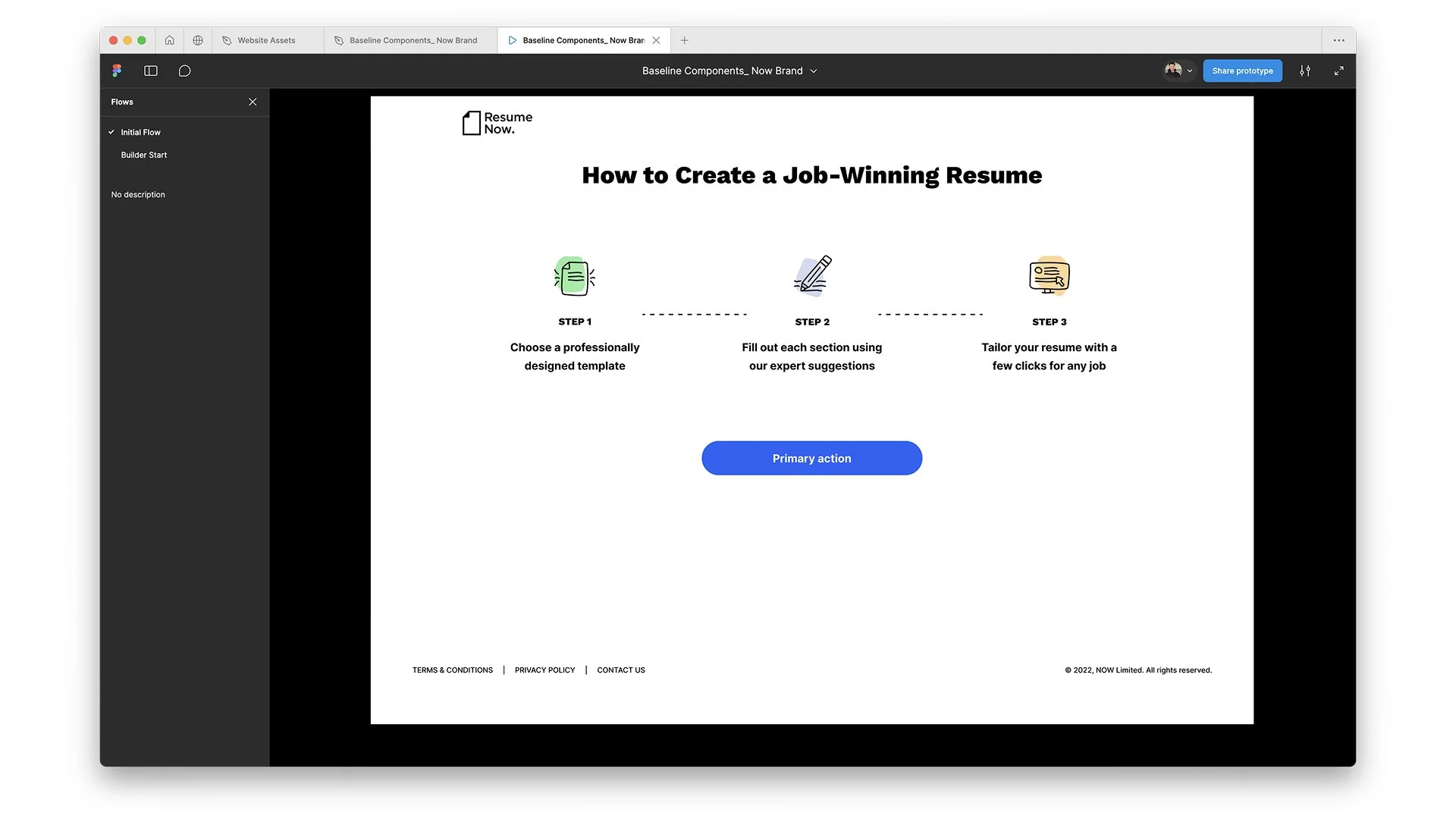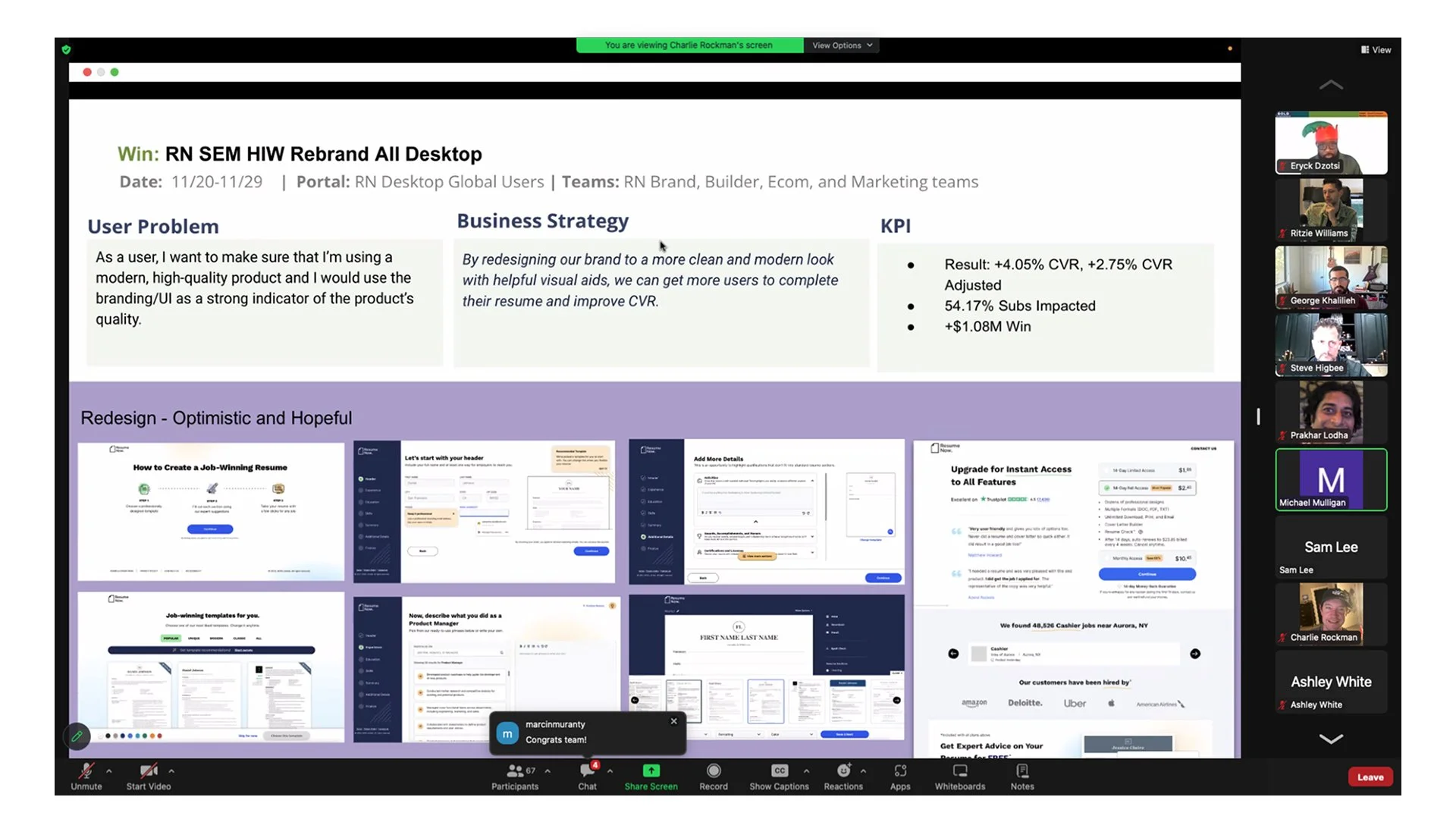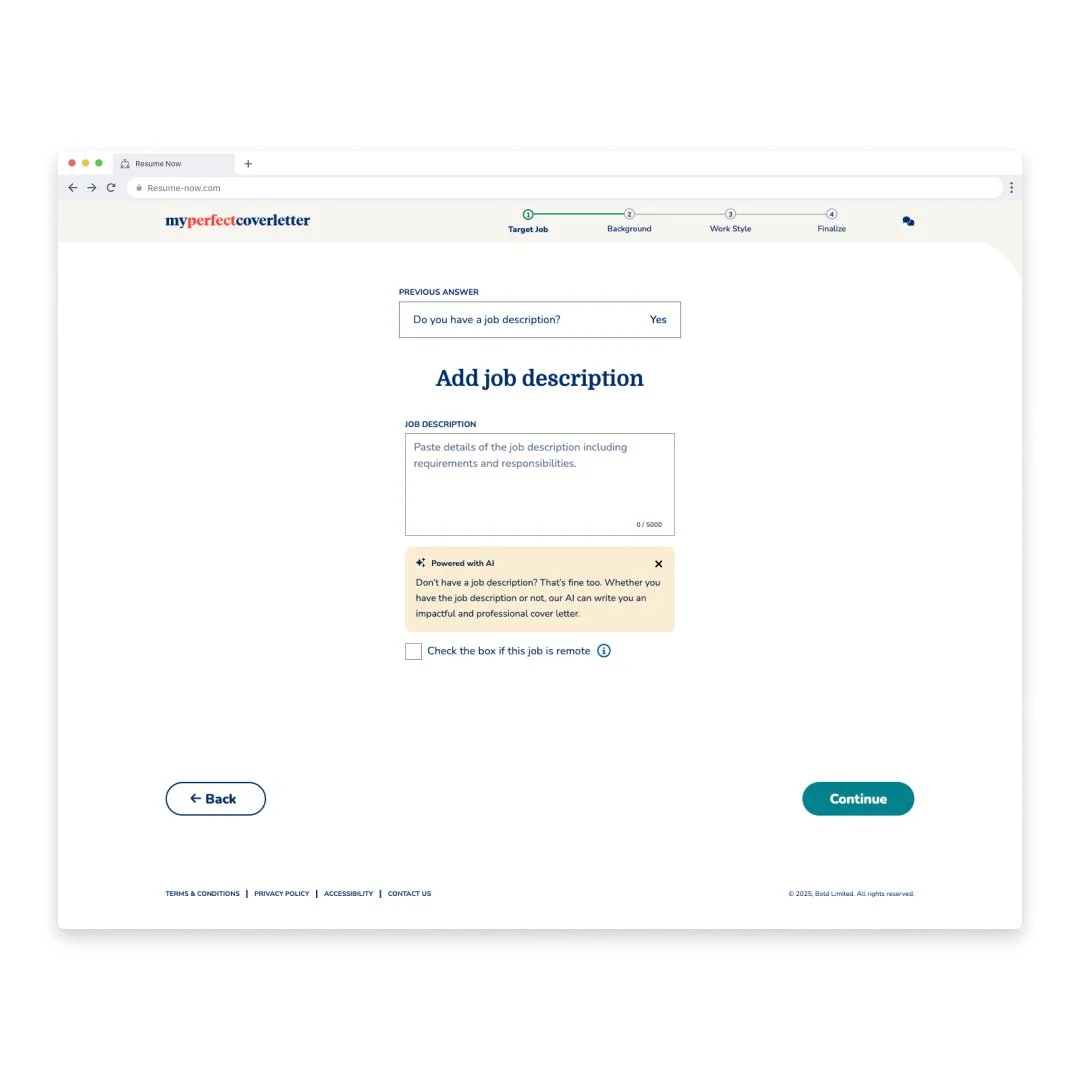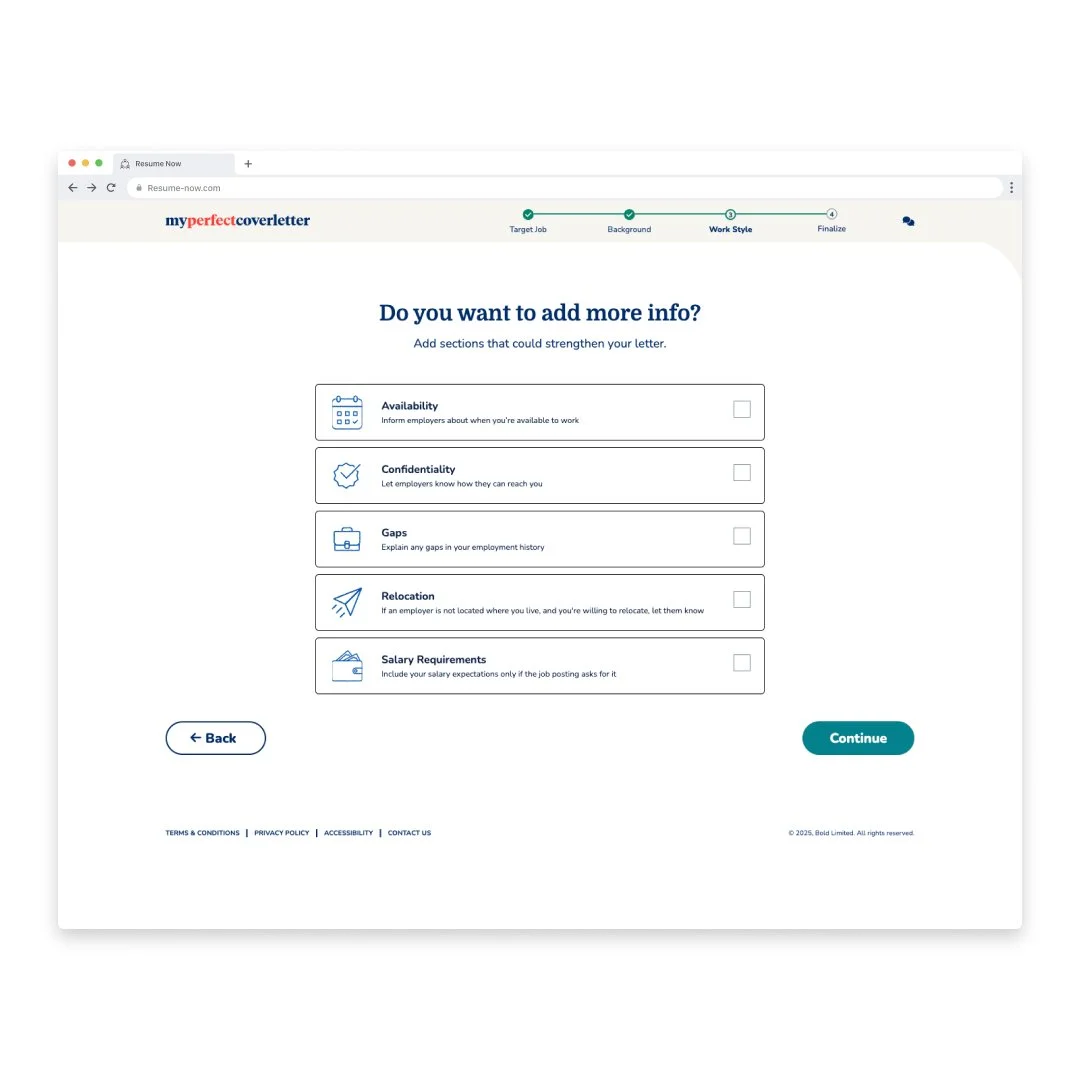Cover Letter Builder
BOLD’s suite of AI-powered cover letter builders helps job seekers create personalized, professional, and ATS-optimized cover letters quickly and efficiently. These tools provide step-by-step guidance, pre-written content suggestions, and customizable templates, making it easier for users to craft compelling cover letters tailored to their desired roles.
The cover letter builders under BOLD’s portfolio include:
Cover-Letter-Now
MyPerfectCoverLetter
LiveCareer Cover Letter Builder
Zety Cover Letter Builder
Each of these products was designed to provide:
Dynamic content suggestions that help users articulate their experiences and strengths effectively.
Customizable templates that match various industries and professional styles.
ATS-friendly formatting to increase the chances of passing applicant tracking systems.
Seamless integration with BOLD’s resume builders, allowing users to create a complete application package in minutes.
My Role
As Senior Manager of UX Design and NOW Brand UX Lead, I was responsible for shaping the user experience across all cover letter builders in BOLD’s portfolio, including Cover-Letter-Now, MyPerfectCoverLetter, LiveCareer Cover Letter Builder, and Zety Cover Letter Builder. My role was to enhance usability, optimize conversion rates, and improve content personalization, ensuring that job seekers could effortlessly create compelling, ATS-friendly cover letters.
I led a multi-disciplinary UX team consisting of 4 UX designers, 1 UX manager, 1 visual designer, 1 copywriter, and 1 researcher, working collaboratively with product, engineering, and marketing teams to drive data-driven UX enhancements. Through user research, A/B testing, and iterative design improvements, I helped optimize the cover letter creation process, resulting in higher engagement, improved completion rates, and increased revenue.
A major part of my role involved standardizing the UX approach across all cover letter builders, ensuring consistency in design patterns, user flows, and AI-powered writing assistance features. Additionally, I worked on mobile optimizations, content personalization strategies, and AI-driven features that made the cover letter writing experience more intuitive and tailored to user needs.
Through my leadership, we transformed BOLD’s cover letter builders into efficient, high-converting tools that provided job seekers with an effortless and effective way to present their skills and experiences.
Project Process
To drive efficiency, consistency, and data-driven decision-making, I implemented a structured UX workflow across all of BOLD’s cover letter builders. This process followed the same core framework as Resume-Now, ensuring predictability, scalability, and alignment with product development teams.
Feature Strategy Plan – Prioritizing with RICE
To ensure that we focused on high-impact improvements, we used the RICE framework (Reach, Impact, Confidence, Effort) to evaluate and prioritize new features.
Reach: Estimated the number of users affected.
Impact: Measured the potential improvement in conversion rate, engagement, or completion rates.
Confidence: Assessed based on research, past tests, and data insights.
Effort: Determined the level of design and development complexity.
This data-driven prioritization ensured that we focused on features that maximized business impact and user success.
Planning – Structuring the Work for Execution
Once a feature was approved, we established a clear execution plan:
High-Level Overview from PM – Product managers provided an initial feature brief.
Designer Assignment – A UX designer was assigned based on workload and expertise.
Scoping & Estimation – The team assessed effort, feasibility, and dependencies, ensuring realistic timelines.
Kick-Off – Aligning Teams & Expectations
With planning complete, we aligned on testing strategies, design considerations, and documentation:
Discussed Testing Variants – Identified different design or content variants for A/B testing.
Created a Feature File – Documented key notes, hypotheses, and success metrics using the Feature File Template.
This structured kick-off process ensured alignment across design, product, engineering, and data teams before moving into execution.
Concept Review – Aligning Early Designs with Stakeholders
The assigned designer presented initial low-fidelity concepts to the cross-functional team for feedback.
Early validation helped refine the approach before investing in higher-fidelity designs.
Design Review – Refining & Finalizing Designs
Moved from low-fidelity wireframes to high-fidelity UI designs, using the Baseline File as a foundation.
Presented polished UI/UX to the product team for final feedback.
Ensured all designs followed BOLD’s design system, brand guidelines, and accessibility standards.
Design QA – Ensuring Quality Before Launch
Once the feature was developed, the designer reviewed the final implementation to ensure it matched the intended design specifications.
Provided detailed feedback to developers, addressing any UI inconsistencies before release.
A/B Testing – Measuring Impact on Conversions
Features were tested against the existing baseline to measure effectiveness.
We monitored conversion rates, engagement metrics, and user interactions.
Based on results, we iterated or rolled out the feature fully.
Leadership Results Presentation – Showcasing Impact
Results were presented to executive leadership, demonstrating how each feature improved engagement, revenue, or user experience.
If successful, the feature was fully launched; otherwise, iterations were planned based on data-driven insights.
Key Features & Impact
Throughout my leadership on BOLD’s cover letter builders, I led key UX initiatives that standardized the experience across products, introduced AI-powered customization, and improved user engagement. These improvements resulted in higher conversion rates and significant revenue growth, ensuring a seamless, user-friendly cover letter creation process.
Aligning All Cover Letter Products Under a Unified Builder
Before my involvement, BOLD’s cover letter products (Cover-Letter-Now, MyPerfectCoverLetter, LiveCareer Cover Letter, and Zety Cover Letter Builder) operated independently, each with inconsistent UX patterns, branding, and feature sets.
I led the effort to unify all cover letter builders under a single, scalable framework, ensuring:
Consistent UI/UX across all platforms, reducing confusion for users who interacted with multiple BOLD products.
Standardized design patterns, templates, and content recommendations, creating a smoother cover letter-building experience.
Easier scalability for future updates, allowing us to roll out new features across all products simultaneously.
This initiative streamlined product development, improved user experience, and positioned BOLD’s cover letter tools for long-term growth.
Job Description Customization
🚀 +5.06% CVR Increase | 💰 $156,860 Annualized Revenue
To improve relevance and personalization, we introduced job description customization, allowing users to:
Paste a job description, and the cover letter builder would auto-suggest tailored content based on key qualifications.
Receive AI-driven recommendations to help users align their cover letter with employer expectations.
Improve personalization with dynamic content adjustments, making cover letters more impactful and relevant.
This feature led to a 5.06% increase in conversion rate (CVR), contributing to $156,860 in annualized revenue.
Additional Sections for Customization
🚀 +11.28% CVR Increase | 💰 $204,665 Annualized Revenue
To give users greater flexibility in tailoring their cover letters, we introduced optional content sections, including:
Skills & Achievements – Users could highlight specific competencies relevant to the job.
Passion & Motivation Statements – Allowed users to add a personal touch to their applications.
Call-to-Action Enhancements – Suggested closing statements designed to encourage recruiter engagement.
By allowing deeper personalization, we saw an 11.28% increase in CVR, leading to $204,665 in annualized revenue.
Conclusion
Through UX standardization, AI-powered customization, and personalization enhancements, I helped transform BOLD’s cover letter builders into a more effective and high-converting product suite. These updates not only improved usability and engagement but also generated significant revenue growth, reinforcing the impact of strategic UX leadership on business outcomes.







